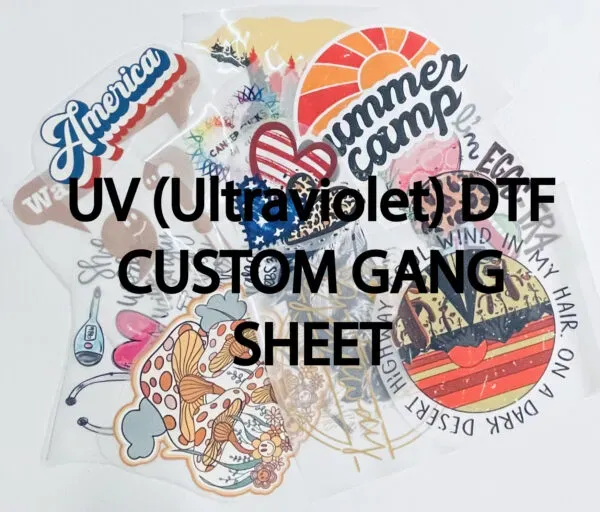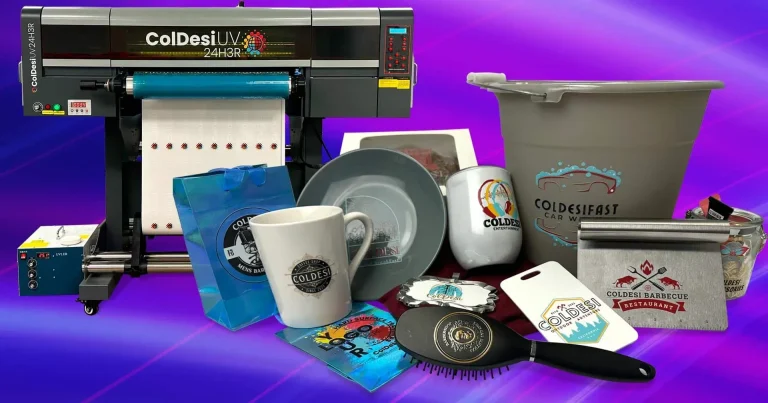In the realm of modern printing innovations, UV DTF Gangheet Technology stands out as a groundbreaking advancement that combines the best of Direct-to-Film printing and ultraviolet curing processes. As industries seek more durable and vibrant printing solutions, this hybrid technology has emerged to meet these demands, offering unmatched flexibility across various substrates. UV DTF printing not only enhances the quality of designs but also promotes sustainable printing practices through reduced waste and resource efficiency. With its ability to produce intricate patterns and vivid color replication, this technology is revolutionizing how businesses approach their branding and product design. Explore with us the intricacies of UV DTF Gangheet Technology and discover its potential to redefine the printing landscape.
Exploring the world of UV Direct-to-Film Gangheet technology reveals a transformative approach to printing that integrates ultraviolet inks and efficient transfer methods. Often referred to as hybrid printing solutions, this technique enhances traditional Direct-to-Film printing by utilizing advanced UV curing, resulting in prints that are not only visually striking but also incredibly resilient. By marrying these two innovative methods, businesses can achieve high-quality, sustainable prints that cater to a diverse array of materials including textiles and rigid substrates. The continuous evolution of this technology highlights a significant shift towards environmentally friendly printing methods, ensuring that industries remain at the forefront of both aesthetic appeal and ecological responsibility. Delving deeper into these developments unlocks a wealth of opportunities for creative professionals and manufacturers alike.
What is UV DTF Gangheet Technology?
UV DTF Gangheet technology signifies a pivotal shift in how we perceive and execute printing processes. It combines the direct-to-film (DTF) technique with ultraviolet (UV) printing technology, creating a method that not only embraces efficiency but also elevates print quality to new heights. By printing vibrant designs directly onto a film that can then be transferred, the method achieves unparalleled detail and color vibrancy. This has made it easier for designers to bring their intricate concepts to life while also ensuring that the prints are durable and eye-catching.
Utilizing UV inks in the DTF process enhances the entire workflow, offering advantages such as quick drying times and lower environmental impact. Traditional inks rely on solvents that can be harmful, while UV inks generally contain fewer volatile organic compounds (VOCs), making them a more sustainable choice. This aspect of UV DTF Gangheet technology positions it as a forward-thinking solution in an era where eco-conscious practices are paramount in the printing industry.
Benefits of UV Printing Technology
UV printing technology provides several compelling advantages that set it apart from conventional printing methods. Firstly, the immediate curing of UV inks through ultraviolet light translates to enhanced productivity. Producers can deliver finished products much sooner without the waiting time associated with drying. This is particularly beneficial in high-demand environments where quick turnaround times directly correlate to increased customer satisfaction and higher revenue.
Additionally, UV printing facilitates remarkable color reproduction. The curing process of UV inks allows for a saturation and vibrancy that is difficult to achieve with traditional inks. This is vital in industries like fashion and advertising, where visual impact is critical. Moreover, UV prints exhibit superior durability against scratches, fading, and moisture, making them suitable for a variety of applications ranging from outdoor signage to high-traffic marketing materials.
The Integration of UV and DTF Technologies
The integration of UV technology with DTF printing revolutionizes the production landscape by marrying the strengths of both methods. This hybrid printing solution not only allows for superior adhesion to various substrates but also provides increased resistance to wear and tear. It represents an evolution in printing that meets consumer demands for high-quality, long-lasting products without compromising on production efficiency.
By combining these technologies, businesses can extend their offerings to include a wider range of materials, such as wood, metal, and glass, alongside traditional fabrics. This versatility broadens market opportunities and makes it feasible for companies to diversify their services. As the industry shifts towards more adaptive and customizable solutions, this technological synergy positions manufacturers to meet diverse customer needs while maintaining a competitive edge in the marketplace.
Applications of UV DTF Gangheet Technology in the Fashion Industry
The fashion industry stands to gain immensely from UV DTF Gangheet technology, as it empowers designers to create visually striking and durable garments. This capability allows brands to unleash their creativity by producing intricate, multicolored designs that stand the test of time. Whether it’s on casual wear or high-end fashion, the options become virtually limitless, allowing for unique, personalized items that resonate with consumers seeking individuality in their attire.
Moreover, the resilience of UV-cured prints enhances the overall longevity of fashion items, leading to greater customer satisfaction and reduced returns. This is especially significant in fast fashion, where the demand for quality and appearance is paramount. Brands can now ensure that their printed garments not only look great but also endure frequent wear and washing, paving the way for sustainable practices in an industry often criticized for its environmental impact.
Sustainable Printing Practices Through UV DTF Technology
As sustainability becomes a focal point in various industries, UV DTF technology rises to the occasion by offering environmentally friendly printing options. The reduced use of harmful solvents and the lower VOC emissions associated with UV inks attract eco-conscious companies looking to mitigate their environmental footprint. This attraction to sustainable practices positions UV DTF technology as a leader in the movement towards greener solutions in printing.
In addition to minimizing ecological impacts, leveraging UV DTF technology encourages better resource efficiency. The technology’s fast curing times allow for shorter production runs and significantly less waste compared to traditional printing methods. Companies can pivot towards sustainable printed products without sacrificing quality or efficiency, aligning their operations with the growing consumer preference for eco-responsible products.
Future Trends in UV DTF Printing Technology
The future of UV DTF printing technology appears promising, as ongoing research and development continue to refine its capabilities. Emerging trends point towards further advancements in ink formulations and printing machinery, which will likely enhance speed, efficiency, and print quality even more. Industry experts predict that as technology evolves, the cost of entry may decrease, allowing even smaller businesses to harness the advantages of UV DTF printing for personalized offerings.
Moreover, as consumer preferences shift toward customization and unique prints, UV DTF technology is poised to meet these demands efficiently. With the rise of digital printing solutions, businesses can quickly adapt to market trends, producing short runs of customized designs without the traditional setup costs. This flexibility not only fosters creativity but also encourages a closer connection between brands and their consumers, reinforcing loyalty through personalized experiences.
Frequently Asked Questions
What is UV DTF Gangheet technology and how does it improve printing quality?
UV DTF Gangheet technology combines Direct-to-Film (DTF) and UV printing techniques to deliver enhanced printing quality. By using UV inks that cure instantly, this innovation allows for vibrant colors and durable prints that adhere firmly to various substrates, making it ideal for both textiles and hard materials.
How does UV DTF Gangheet technology contribute to sustainable printing practices?
UV DTF Gangheet technology promotes sustainable printing through the use of eco-friendlier UV inks, which emit fewer volatile organic compounds (VOCs) compared to traditional inks. This technology also reduces material waste by streamlining the printing process, leading to more sustainable production methods.
What are the advantages of using UV DTF Gangheet technology in the fashion industry?
In the fashion industry, UV DTF Gangheet technology offers several advantages, including the ability to produce high-resolution prints on garments that are not only visually striking but also resistant to wear. This ensures that designs maintain their vibrancy and durability over time, enhancing product longevity and customer satisfaction.
Can UV DTF Gangheet technology be applied to hard substrates like metal or glass?
Yes, UV DTF Gangheet technology is versatile and can be used on hard substrates such as metal, glass, and wood. The UV-curing process creates a strong bond with these materials, allowing for high-quality prints that are both durable and visually appealing.
What industries can benefit from UV DTF Gangheet technology?
UV DTF Gangheet technology has wide applications across several industries, including fashion, advertising, and packaging. Businesses in these sectors leverage this printing innovation to produce unique designs, promotional materials, and packaging solutions that stand out while ensuring durability.
What future trends are shaping the development of UV DTF Gangheet technology?
Key trends influencing UV DTF Gangheet technology include a growing demand for customization, advancements in digital printing, and an emphasis on sustainability. As technology evolves, we can expect further enhancements in print quality, efficiency, and ecological friendliness.
| Key Points | Details |
|---|---|
| Understanding DTF Technology | A cutting-edge printing method that transfers designs onto various surfaces, including textiles and plastics. |
| The Role of UV Printing | Utilizes ultraviolet light to cure inks quickly, enabling vibrant colors and improved durability. |
| Integration Benefits | Enhanced adhesion, versatility across substrates, and cost-effectiveness make this hybrid technology appealing. |
| Applications | Applicable in fashion, advertising, and packaging, transforming how products are printed and marketed. |
| Recent Developments | Increased investment in advanced machines indicates growing adoption and improved print specifications. |
| Trends Influencing the Market | Sustainability, customization, and digital advances are shaping the future of UV DTF printing. |
Summary
UV DTF Gangheet Technology represents a groundbreaking shift in printing processes, combining the strengths of Direct-to-Film (DTF) and UV printing methods. This hybrid approach drastically enhances print quality, durability, and versatility, allowing for vibrant color reproduction on a variety of substrates. It addresses the market’s increasing demand for efficient, sustainable, and high-quality printing solutions, making it a favored choice among manufacturers in several industries, including fashion and advertising. With ongoing advancements in technology and increased investment in production capabilities, UV DTF Gangheet technology is poised to revolutionize the printing landscape, offering exciting opportunities for innovation and creativity.







